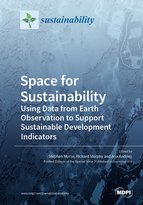Space for Sustainability: Using Data from Earth Observation to Support Sustainable Development Indicators
A special issue of Sustainability (ISSN 2071-1050).
Deadline for manuscript submissions: closed (31 December 2021) | Viewed by 31596
Special Issue Editors
Interests: sustainability assessment; sustainability indicators; natural resource management; earth observation; participatory techniques
Special Issues, Collections and Topics in MDPI journals
Interests: bioenergy and biomaterials; life cycle assessment
Special Issues, Collections and Topics in MDPI journals
Special Issue Information
Dear Colleagues,
Global progress towards living sustainably is now urgent. Actions for sustainability are typically informed through the use of indicator-based frameworks encompassing diverse attributes of the environmental, social and economic dimensions of ‘sustainability’. Reporting on such indicators is embedded in frameworks such as the United Nations Sustainable Development Goals (SDGs) with the primary responsibilities for reporting carried by national and local governments. Additionally, many businesses and public bodies (e.g. universities, health services) are increasingly under internal and external pressure to similarly report via these sustainability indicators, especially as part of the SDGs, and such reporting is of increasing interest to investors and the financial services sectors from a risk and assurance perspective. However, the use of these indicator-based frameworks face many challenges. One of the most significant of these is the challenge of acquiring sufficient, timely and good quality data to populate these indicators via ‘conventional’ methods (e.g. surveys at the local, national or corporate level) as this is often expensive and time consuming. Many developing regions, in particular, suffer from a lack of resources or established systems for such data collection and, indeed, it is also proving to be challenging for more developed economies.
One approach to address this issue of data provision for indicators of Sustainable Development (SD) is the use of Earth Observation (EO). EO-based data, geospatial information and ‘big data’ can support the population of sustainability indicators at all scales, and the integration of these sources is a step forward in advancing the well-being of our societies. While EO derived data have been used for many years to assess important issues such as deforestation and changes in land use, their use to address more socio-economic issues (e.g. inequality, poverty, corruption, health care) within SD remains limited. Nonetheless, EO tools and technologies are developing rapidly with an expanding range of capabilities, resolutions, frequency, data power, accuracy etc., and this is anticipated to continue into the foreseeable future.
This Special Issue in the journal Sustainability aims to present the current ‘state of play’ with regard to the use of EO data for SD indicators, and given the rapid progress in the field it provides a timely and welcome milestone in the journey. The editors welcome contributions that explore progress to date and how this informs potential for future use of EO derived data for many aspects of SD and that provide cutting-edge examples of where EO can provide insights, particularly for a number of the socio-economic dimensions of SD that have proved to be challenging to assess. This could include, but is not limited to, the following applications:
- Applications of EO in tracking the state of socio-economic issues at sub-national, national and regional levels;
- Integration of EO with survey data;
- Filling traditional data gaps using EO data;
- Assessing inequalities, poverty, food insecurity, water scarcity using EO data
Papers submitted should include an uncertainty assessment of the approach and ideally a cost-effectiveness analysis that might highlight the usefulness of using EO data.
We very much look forward to your submissions.
Prof. Dr. Stephen Morse
Prof. Dr. Richard Murphy
Ms. Ana Andries
Guest Editors
Manuscript Submission Information
Manuscripts should be submitted online at www.mdpi.com by registering and logging in to this website. Once you are registered, click here to go to the submission form. Manuscripts can be submitted until the deadline. All submissions that pass pre-check are peer-reviewed. Accepted papers will be published continuously in the journal (as soon as accepted) and will be listed together on the special issue website. Research articles, review articles as well as short communications are invited. For planned papers, a title and short abstract (about 100 words) can be sent to the Editorial Office for announcement on this website.
Submitted manuscripts should not have been published previously, nor be under consideration for publication elsewhere (except conference proceedings papers). All manuscripts are thoroughly refereed through a single-blind peer-review process. A guide for authors and other relevant information for submission of manuscripts is available on the Instructions for Authors page. Sustainability is an international peer-reviewed open access semimonthly journal published by MDPI.
Please visit the Instructions for Authors page before submitting a manuscript. The Article Processing Charge (APC) for publication in this open access journal is 2400 CHF (Swiss Francs). Submitted papers should be well formatted and use good English. Authors may use MDPI's English editing service prior to publication or during author revisions.
Keywords
- Earth Observation
- Sustainable Development
- Indicators
- Data Management and Use
- Socio-Economic
- Big Data








